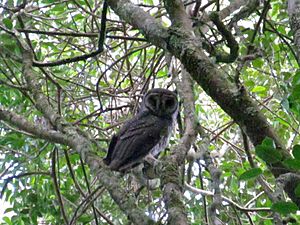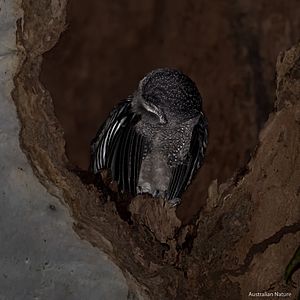Greater sooty owl facts for kids
Quick facts for kids Greater sooty owl |
|
|---|---|
 |
|
| Conservation status | |
| Scientific classification | |
| Genus: |
Tyto
|
| Species: |
tenebricosa
|
| Subspecies | |
|
T. tenebricosa arfaki |
|
 |
|
| The distribution of the greater sooty owl | |
The greater sooty owl (Tyto tenebricosa) is a medium to large owl. You can find these owls in south-eastern Australia and the rainforests of New Guinea. They have also been seen on Flinders Island.
These owls have a head with fine white spots. Their wings also have scattered white spots. Female greater sooty owls are usually lighter in color than males. Females are about 37–43 cm long and weigh 750-1200 grams. Males are the same length but weigh less, around 500-700 grams. Their wings can be 30–40 cm long.
Greater sooty owls have large, dark eyes. These eyes are set in a big, round facial disk. This facial disk is dark gray-silver or sooty black, and its color changes as the owl gets older. It has a thick black edge. The top part of the owl's body is black to dark gray, and its belly is lighter. They have a short tail and feathered legs. Their feet and talons (claws) are very large. Their call is a loud shriek that can last up to two seconds.
There is another owl called the lesser sooty owl (T. multipunctata). Some scientists think it is the same species as the greater sooty owl. If so, they are both called "sooty owls." The lesser sooty owl is much smaller. It lives in the wet tropical areas of North Queensland, Australia.
Contents
Sooty Owl Habitat
Greater sooty owls are active at night, which means they are nocturnal. During the day, they rest in large tree hollows, caves, or thick leaves. They are hard to see or hear. You can find them in moist forests with deep valleys. These areas often have smooth-barked gum trees, tree ferns, and wet plants on the ground. They might hunt for food in drier places. However, they usually rest and raise their young in the wetter areas.
What Sooty Owls Eat
Greater sooty owls mostly eat mammals. These can be large tree-dwelling marsupials like the greater glider. They also eat ringtail possums, sugar gliders, bandicoots, rodents, and small marsupials called antechinus. Sometimes, they also catch birds, bats, and insects.
Their eating habits have changed since people settled in their areas. This might be because there are fewer ground animals now. So, they tend to eat more animals that live in trees.
Sooty Owl Behavior
Greater sooty owls are very territorial. This means they protect their living space. Scientists believe they stay in the same area for their whole adult lives. Sooty owls make different kinds of sounds. These include rasps and screams, like a barn owl. They also have a special "falling bomb" call. When they are close to other sooty owls, they make an insect-like twittering sound.
Sooty Owl Life Cycle
Greater sooty owls build their nests in large hollow trees or caves. The female owl stays in the nest for several weeks before laying her eggs. She usually lays one or two dull white eggs. They typically start nesting between January and June. However, they can nest at almost any time of the year, depending on where they live and the weather.
The eggs hatch after about 42 days. The male owl brings food to the female, who rarely leaves the nest during this time. The young owls are born with soft gray feathers. They can fly when they are about three months old. Young owls stay with their parents for a long time after they learn to fly. We don't know how long greater sooty owls live. They are territorial and stay in their home area all year round.
Protecting Sooty Owls
Around the World
The greater sooty owl is not considered globally threatened. This means its population is stable worldwide.
In Australia
In Australia, the greater sooty owl is not listed as threatened under the national Environment Protection and Biodiversity Conservation Act 1999. However, its protection status can be different in each Australian state. For example:
- In Victoria, the sooty owl is listed as threatened under the Flora and Fauna Guarantee Act (1988). An Action Statement has been created to help recover and manage this species.
- On Victoria's 2007 list of threatened animals, the sooty owl is listed as vulnerable.
- In New South Wales, the sooty owl is listed as vulnerable under the Threatened Species Conservation Act (1995).
See also
 In Spanish: Lechuza tenebrosa para niños
In Spanish: Lechuza tenebrosa para niños



